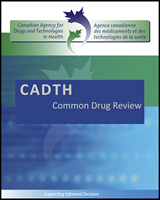3INTERPRETATIONS AND KEY LIMITATIONS
The following limitations with the manufacturer’s submission were noted:
Lack of data to support second-line therapy. In the clinical studies, only a small proportion of patients received ingenol mebutate after having received 5-FU. Although the results of a subgroup analysis for this population are generally similar to the overall patient population, the results appear to indicate that ingenol mebutate works better as a first-line topical agent. However, the population is small and thus the robustness of these results is uncertain. The majority of the clinical data are for use as a first-line treatment, in line with the Health Canada indication.
No robust evidence that ingenol mebutate gel is equivalent to 5-FU and/or imiquimod 5%. As indicated in
Appendix 7 of the clinical report, the systematic review by Gupta et al. (2012)
6 does not adequately assess the indirect treatment comparison of ingenol mebutate gel 0.015% versus 5-FU or imiquimod 5% in patients with AK on the face or scalp; or ingenol mebutate gel 0.05% versus 5-FU in patients on the trunk or extremities. Although the systematic review met all assessing methodological quality of systematic reviews (AMSTAR) criteria and is considered to be of high methodological quality, it was limited by the heterogeneity and low methodological quality of the included studies.
Model cycle time may not be appropriate. The manufacturer stated that clinical experts consulted indicated that patients would be reassessed between four and six months after treatment, but use a six-month cycle as opposed to a four-month cycle. The clinical expert consulted by the Common Drug Review (CDR) indicated that assessment at four months was more likely to be appropriate. During the two-year period, the use of a four-month cycle substantially increases the incremental cost of ingenol mebutate compared with 5-FU compared with using a six-month cycle. Therefore, the use of a six-month cycle by the manufacturer has likely underestimated the actual treatment costs.
Adherence and persistence. The manufacturer’s analysis did not consider the potential for greater adherence and persistence rates with ingenol mebutate when compared with either comparator due to the substantially shorter treatment duration with ingenol mebutate. The benefits from the shorter treatment duration cannot be seen in the submitted analysis. The only available data related to persistence and adherence are from a patient survey from the UK, in which persistence and adherence rates for ingenol mebutate (~70%) were higher compared with 5-FU (45% to 52%). However, by not taking the improved adherence and persistence into account, the manufacturer may have underestimated the total cost of treatment with ingenol mebutate compared with the comparator treatments.
Inappropriate pricing of imiquimod 5%. It would have been more appropriate to use prices from plans that participate within the CDR process as opposed to using Régie de l'assurance maladie du Québec (RAMQ) pricing in the cost comparison. The submission also presents the results using the cost of exactly 32 doses, although the manufacturer only supplies the imiquimod 5% in packs of 24 and 12. It is thus likely to have wastage (assuming all 32 doses are prescribed). This needed to be taken into account when determining the cost of this comparator, which may increase or decrease the cost of imiquimod 5%, depending on the prescribing habits of clinicians.

